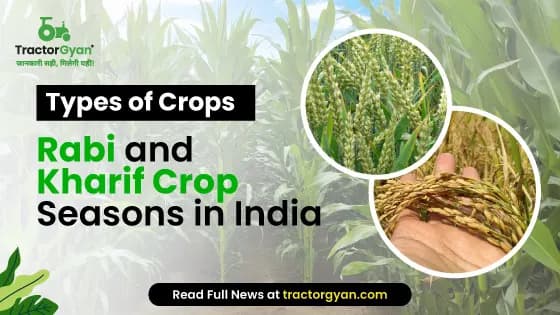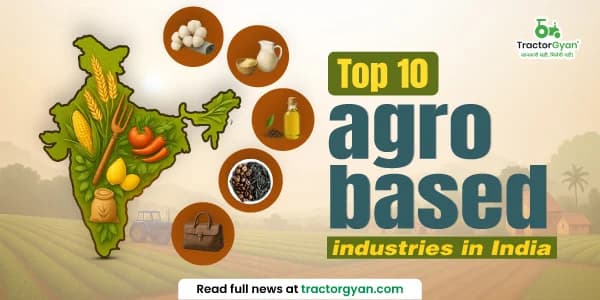Rabi and Kharif Crop Seasons in India - Types, Factors | Tractorgyan
टेबल ऑफ कंटेंट
With its various climates and agricultural environment, India has a long history of farming crops that correspond to particular seasons. In India, the agricultural calendar is divided into two seasons known as "Rabi crop season" and "Kharif crop season."
As a skilled farmer, it's important to understand the difference between the Rabi and Kharif crop seasons because each season has its own set of possibilities and difficulties. Knowing how to grow these seasonal crops can increase the crop yield.
It also ensures that India's various agricultural landscapes can support farming for a long time. In this article, we will look at the Rabi season and Kharif seasons in India, along with crops that are commonly grown during each season. So, let's get started.
Types of Crops Seasons In India
Based on the climatic conditions and crops grown during those seasons, India has two main crop seasons which are the Kharif crop season and the Rabi crop season. Let’s understand these seasons in detail.
Kharif Season

Often known as monsoon crop season, Kharif crop season is the time of year when farmers plant and harvest crops that can thrive in the rainy season.
The Kharif season usually starts with the arrival of the southwest monsoon, which supplies plenty of rain to the region. This season in India begins around June and lasts until September or October. Water availability during this period enables the growth of a variety of crops that thrive in damp and warm environments.
Rabi Season

The Rabi crops season in India refers to the period when farmers cultivate and harvest specific crops that need a cooler environment for proper growth and sustainability.
The Rabi season mainly starts in October or November and extends until March or April. Some main weather conditions of this season are cooler temperatures, lower rainfall, and longer daylight hours. The term "Rabi" comes from the Arabic word for spring, as the crops grown during this season mature and are harvested in the springtime. The Rabi crops are mainly planted in the plains and cooler regions of India.
Now that the basic meaning of India’s main crop seasons is clear, it’s time to learn about the rabi crops that are grown during these seasons.
What Are Rabi Crops?
Rabi crops also known as Winter crops are grown during the winter season or Rabi farming seasons that typically start in October and March. Rabi crops require less water to grow. Therefore, rabi crops can easily grow with the help of routine water irrigation to flourish.
Farmers often rotate Rabi crops with legumes like pulses to enrich the soil with nitrogen. It helps the land to remain fertile for future Kharif crops. Types of Rabi crops include Wheat, Barley, Pulses, Gram, and more. Moreover, farmers also sow seeds of Mustard, Cumin, Sunflower, Rapeseed, and more during the rabi season.
Rabi Crops Examples: Some examples of rabi crops grown in India are wheat, mustard, barley, green peas, sunflower, coriander, cumin, etc.
Wheat
India's agricultural income comes mainly from wheat production, which is also the most common rabi crop. India is the second-largest producer of this wheat crop in the world. Wheat requires low temperatures to grow, so winter is the suitable season for farming this Rabi crop.
The ideal temperature range should be around 140 to 180 degree C with a rainfall of 50 cm to 90 cm. The crop is harvested in spring when the temperature is slightly warm. In India, Uttar Pradesh is the largest wheat-producing state, closely followed by Punjab and Haryana.
This crop is typically cultivated from October to December in various Indian states, depending on the climatic conditions, and harvested around February to May, again depending on the climate and the time of sowing.
Mustard
India is the world leader in mustard production. Mustard seeds are planted in October and harvested in April. This oilseed crop, which thrives in milder climates, supplies much of India's edible oil.
Barley
Rajasthan, Uttar Pradesh, and Haryana produce much barley. Most barley is planted in October and harvested in April. It is an important Rabi crop used in food, feed, and brewing, especially beverage malt.
Green Peas
Green peas are planted in October and picked between January and March. They are a famous vegetable in Indian food because they are healthy and can be used in many different ways.
Sunflower
India grows a small amount of sunflowers. Most of the time, sunflowers are grown in October and picked in March-April. Sunflower oil is a famous cooking oil in India because of its health benefits.
Coriander
The Indian states of Madhya Pradesh, Rajasthan, and Gujarat are the world's leading producers of coriander. It is grown in well drained loamy soil. Sowing occurs in October, and harvesting occurs in April.
Cumin
India leads the globe in cumin output. It is produced from November to December and harvested between February and March. It is a key spice in Indian cooking defined by its taste and is widely exported for culinary use around the world.
|
Crop Name |
Rainfall |
Temperature |
Major Producing Areas |
|
Wheat |
50-90 cm |
14-18°C |
Uttar Pradesh, Punjab, Haryana |
|
Barley |
40-100 cm |
12-15°C |
Rajasthan, Uttar Pradesh, Haryana |
|
Mustard |
25-40 cm |
10-25°C |
Rajasthan, Haryana, Madhya Pradesh |
|
Peas |
50-75 cm |
10-18°C |
Uttar Pradesh, Madhya Pradesh, Punjab |
|
Sunflower |
30-50 cm |
20-25°C |
Karnataka, Maharashtra, Andhra Pradesh |
|
Coriander |
50-75 cm |
15-25°C |
Rajasthan, Gujarat, Madhya Pradesh |
|
Cumin |
30-40 cm |
20-30°C |
Rajasthan, Gujarat, Madhya Pradesh |
What Are Kharif Crops?
The word Kharif is also an Arabic term that means ‘Autumn’ and Kharif crops are mainly harvested in this season (September or October). Kharif crops are also known as monsoon crops as they are sowed in monsoons.
Moreover, they grow well in rain-fed areas with hot and humid climates. They are also highly dependent on rainfall patterns. The amount and timing of rain are the two most important parameters determining the output of the Kharif crop.
These crops are harvested at the end of the monsoon season, and their seeds are sown at the start of the monsoon season. Soybean is intercropped with Kharif crops in several locations to increase income and soil fertility by fixing nitrogen.
However, the Kharif crop season in India differs from state to state. The general period of sowing begins from June till November, depending on the area. The sowing season differs according to the arrival of monsoons in different parts of India.
For example, in southern states like Kerala and Tamil Nadu, Kharif crop seeds are generally sown towards the end of May, whereas in northern regions like Punjab and Haryana, seeds are planted around June.
Kharif Crops Examples: Some examples of Kharif crops are rice, bajra, groundnut, cotton, pulses, maize, oilseeds, etc.
Rice
Rice is the most common Kharif crop in India. India produces 20% of the world’s rice, second only to China. Rice mainly grows in regions with heavy rainfall or requires rainfall of more than 100 cm and an average temperature of 25 degrees Celsius.
This kharif crop is traditionally grown in waterlogged rice paddy fields. West Bengal is the largest rice-producing state in India because all these climatic conditions are well met.
Rice is a Kharif-season crop farmed in many Indian states. West Bengal, Uttar Pradesh, and Punjab rank first, second, and third, respectively, in rice production. Rice is also grown in other states, such as Orisha, Assam, Karnataka, and many others.
Clayey or loamy soils with a high water retention capacity are used to grow them. Developing hybrid rice types has boosted India's rice output, allowing farmers to yield more even in harsh climates.
Maize
After rice and wheat, maize is India's third-largest cereal crop. Maize is sown in June-July and harvested in September-October. It grows well on well-drained, loamy soils and is used for food and fodder.
Cotton
Maharashtra, Gujarat, and Telangana are India's top cotton producers. Cotton is planted in June - July and harvested in October–January. It grows in black cotton and alluvial soil. Cotton is essential for the textile industry.
Groundnut
Gujarat produces the highest amount of groundnuts. They are sown in June-July and harvested in October-November. The groundnuts are used for cooking oil production and need well-drained sandy loam soil.
Bajra
Bajra is sown in June-July and harvested in September-October. It thrives on sandy loam to light loam. Bajra is drought-resistant and vital in arid and semi-arid diets.
Pulses
India grows the most pulses. They are sown in June-July and harvested in November-December. Pulses thrive on loamy, well-drained soil. Nitrogen-fixing by them is essential for protein consumption and soil fertility.
Oilseeds
Indian oilseed production is high, notably in Gujarat, Madhya Pradesh, and Maharashtra. Sesame, soybean, and groundnut are planted in June-July and harvested in September-November. They need sandy loam and well-drained loamy soil.
|
Crop Name |
Rainfall Required |
Temperature Required |
Major Producing Areas |
|
Rice |
100-150 cm |
25-35°C |
West Bengal, Uttar Pradesh, Punjab |
|
Maize |
50-100 cm |
21-27°C |
Karnataka, Madhya Pradesh, Bihar |
|
Cotton |
50-100 cm |
21-30°C |
Maharashtra, Gujarat, Andhra Pradesh |
|
Groundnut |
50-75 cm |
25-30°C |
Gujarat, Tamil Nadu, Andhra Pradesh |
|
Bajra (Pearl Millet) |
40-60 cm |
25-30°C |
Rajasthan, Maharashtra, Gujarat |
|
Pulses |
50-75 cm |
20-30°C |
Madhya Pradesh, Maharashtra, Rajasthan |
|
Oilseeds |
50-75 cm |
20-30°C |
Gujarat, Rajasthan, Madhya Pradesh |
Difference Between Kharif Crops and Rabi Crops

|
Differentiation |
Kharif Crops |
Rabi Crops |
|---|---|---|
|
Temperature |
Kharif crops require warm temperatures. |
Rabi crops are grown in cool temperatures. |
|
Season |
The ideal farming season for these crops is early summer and mid-summer. Perfect months for these crops are mid-May or the beginning of monsoons. |
Rabi crops are generally cultivated in the months of October to December as the temperature during these months is low. |
|
Water requirements |
Kharif crops generally have more water requirements. The roots of these crops have to be submerged in water for optimal growth. |
Rabi crops don’t require too much water supply. |
|
Crops duration |
Kharif crops has a short harvesting duration. This is why farmers have two harvests of many crops in one farming season. |
As compared to Kharif crops, the crop growth cycle of Rabi crops is longer. Most of the rabi crops only yield one harvest per season. |
|
Ideal Region |
The ideal geographical regions for these crops are plains and topical parts of India. |
Rabi crops are mostly grown in hilly areas of Northern India as temperatures in these regions are cooler than in the rest of India. |
|
Examples |
Kharif Crops Examples - Maize, Cotton, Rice, Jowar, and Groundnut |
Rabi Crops Examples - Barley, Peas, Wheat, Oilseeds, and Gram |
How do Different Seasons Affect the Crops?
The majority of field crops rely solely on the weather to provide life-sustaining water and energy. The comfort and food supplies of livestock are also dependent on the weather. Adverse weather/climatic conditions can occasionally result in less productivity, especially if they occur during the maturity stages.
Because of the warmer spring climate, farmers can sow the first crop (winter barley) earlier than usual, allowing them to cultivate the second crop (rapeseed) for the remainder of the season, improving soil fertility and income. To cope with unpredictable weather, farmers are using polyhouse cultivation and drip irrigation.
The availability of sufficient water and fertile soil (soil deposition is driven by water transportation) is another limiting factor of cropland growth in the area. Therefore agricultural expansion and intensification are currently confined to a specific distance from main river systems.
Factors Affecting Crop Production Other Than Kharif and Rabi Season

Agriculture is one such industry that is highly influenced by multiple factors. Above, we explained the impact of seasons on crops and their production. However, more factors play a crucial role in crop production across India. Let’s review them quickly.
Internal Factors Affecting Rabi and Kharif Crop Season
Genetics and hereditary: Genetics and hereditary processes used in the crop production process have a great role to play in the quality and quantity of the harvested crop. Different crop varieties or cultivars possess distinct genetic traits that affect factors such as yield, disease resistance, drought tolerance, and maturity period. Plant breeding and genetic engineering techniques are employed to develop improved crop varieties with desirable traits.
Hormonal Regulation: Plants do have hormones and hormones like auxins, gibberellins, cytokinins, abscisic acid, and ethylene, which play crucial roles in regulating various aspects of plant growth and development. They are all crucial for regulating seed germination, root and shoot growth, flowering, fruit development, and senescence. Plants having hormonal imbalances will have delayed production.
External Factors Affecting Rabi and Kharif Crop Season
Climatic conditions: Climatic conditions like temperature, atmospheric pressures or humidity, precipitation, gasses, or wind velocity are all responsible for affecting the production of the crop.
Biotic factors: Biotic factors are beneficial and harmful too as they are caused by living organisms such as plants and animals.
Physiographic conditions: Light and wind exposure: a mountain slope exposed to low light intensity and strong dry winds may provide poor agricultural yields (coastal areas and interior pockets)
Socio-economic conditions: Appropriate crop selection by humans to meet the food and fodder needs of agricultural households.
How Do Tractors Improve Crop Production
In modern farming, tractors are very important for growing more Rabi and Kharif crops. Farmers can now take better care of larger areas of land with the help of machines and with less physical work. This is how tractors help grow more crops:
Efficient Planning: To ensure timely planting, it is essential to use tractors to prepare the field as soon as possible, particularly in situations when there is little time between harvest and planting. The monsoon sets Kharif's season of agricultural sowing. Level an area faster, plough, and till with a tractor.
Precise Planting: Using modern planting technology, tractors sow seeds at the correct depth and distance apart to enable optimum growth and sprouting.
Better Irrigation: Kharif plants need a lot of water to grow. Tractors make it easy to water these plants. They set up and maintain sprinklers and drip lines, which save water and help plants grow better.
Using Fertilisers: Tractors can spread fertilisers properly over large areas, which helps plants grow. Rabi crops, like wheat and barley, need this element to keep their protein amounts steady.
Harvest on Time: Tractors are a big part of the gathering method. Tractors that harvest and process crops help them grow faster and protect them from bad weather. Because things grow and taste better when the right trucks are used at the right time, this is very important.
Conclusion
India’s economy is mainly driven by agriculture and a huge part of its population is actively engaged in farming. With strategic planning and the use of modern technology, Indian farmers are taking care of domestic and international footing requirements.
The Indian agriculture industry is heavily influenced by the diverse climatic conditions and farmers need to be aware of the crops that are perfect for each season. Kharif crops season and Rabi crops season are two major seasons in India and crops grown during these seasons have different requirements.
Indian farmers are privileged enough to have a wide range of crops suitable for different crop seasons. They cultivate crops that can thrive in specific climatic conditions and make a decent living. India's economy relies on agriculture, and understanding Kharif and Rabi crop seasons is crucial to sustaining millions of lives.
कैटेगरी
और ब्लॉग पढ़ें
सभी ट्रैक्टर प्रेमियों का ट्रैक्टर ज्ञान में स्वागत है। हम एक बार फिर आपके लिए भारत की 10 सबसे बेहतरीन ट्रैक्टर कंपनियों का ताजा आंकड़ा लेकर आए हैं। इस लेख में हम आपको बताएंगे कि कौन सी कंपनी किस स्थान पर आती...
भारत एक कृषि प्रधान देश है, ये तो हम जानते ही है। क्या आपको पता है कि भारत के किस राज्य में सर्वाधिक कृषि होती है और किस राज्य में कौन सी फसल होती है? अगर नहीं तो यह ब्लॉग आपकी मदद...
Mumbai, March 1, 2023: Mahindra & Mahindra Ltd.’s Farm Equipment Sector (FES), part of the Mahindra Group, today announced its tractor sales numbers for February 2023.
Domestic sales in February 2023 were at 24,619 units, as against 18,910 units during February 2022.
Total...
इसके बारे में अपनी टिप्पणी लिखें Rabi and Kharif Crop Seasons in India - Types, Factors | Tractorgyan
.webp&w=1920&q=75)
ट्रैक्टर और कृषि से जुड़े सबसे अधिक खोजे जाने वाले ब्लॉग्स
07 Jan 2026
18 Dec 2025
29 Jul 2025
08 Sep 2025
03 Jul 2025
30 Jul 2025
30 Jul 2025
30 Jul 2025
29 Jul 2025
30 Jul 2025
26 Dec 2025
31 Jul 2025
18 Dec 2025
26 Dec 2025










.webp&w=1200&q=75)


.webp&w=2048&q=75)









.webp&w=2048&q=75)
.webp&w=2048&q=75)




























